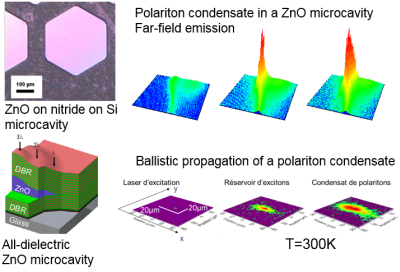Rechercher
Accueil > La Recherche > Axes & Equipes > Physique de l’Exciton, du Photon & du Spin > Optique des états collectifs et des spins (OECS) > Etats collectifs dans les semiconducteurs > Physics of microcavities : spin dynamics, polariton condensates and lasers
Polariton condensates in GaN and ZnO microcavities
publié le

Polariton condensates in microcavities form a model system for the realization and control of collective quantum states, inspired from atomic condensates. GaN and ZnO are semiconducting materials with strong excitons, in terms of binding energy and oscillator strength. They are therefore especially interesting for the generation and control of polariton condensates, that we study at room temperature. Here is a review, written in 2016, of this research field [1].
The realization of high quality factor ZnO microcavities constituted a strong technological challenge. We have demonstrated in 2011 the first ZnO polariton laser [2], operating at 120K in an hybrid cavity (ZnO active layer, dielectric and nitride mirrors on silicon, Q=450). Following a fully different approach, we demonstrated polariton condensation at room temperature [3] (ZnO active layer between dielectric mirrors on glass,Q>2000, Rabi splitting reaching 250 meV). We have drawn the full phase diagram of the polariton laser, from the thermodynamic to the kinetic regimes of operation, as well as mivrocavities on Si substrates [4]. More recently, 2D imaging allowed us to investigate the spatial dynamics of the condensate, its ballistic propagation, and to compare it with simulations [5] [6].
Our ongoing projects aim at demonstrating an electrically injected polariton laser and exploiting the nonlinearities of the polaritons for advanced functionalities.
Collaborative projects :
- ITN Clermont4 (Exciton-polaritons : Physics and Applications, 2009-2013) ;
- ANR ZOOM (Zinc oxide optical microcavities, Blanc, 2006-2009)
- ANR Plug and Bose (Room-temperature electrically-injected polariton lasers, 2017-2020)
[1] Polariton condensates at room temperature
T. Guillet, C. Brimont
Comptes Rendus de l’Académie des Sciences - Physique 17, 946(2016), arxiv:1603.05093
[2] Polariton lasing in a hybrid ZnO bulk microcavity
T. Guillet, M. Mexis, J. Levrat, G. Rossbach, C. Brimont, T. Bretagnon, B. Gil, R. Butté, N. Grandjean, L. Orosz, F. Réveret, J. Leymarie, J. Zúñiga-Pérez, M. Leroux, F. Semond, S. Bouchoule
Appl. Phys. Lett. 99, 161104 (2011)
[3] From Excitonic to Photonic Polariton Condensate in a ZnO-Based Microcavity
Feng Li, L. Orosz, O. Kamoun, S. Bouchoule, C. Brimont, P. Disseix, T. Guillet, X. Lafosse, M.Leroux, J. Leymarie, M. Mexis, M. Mihailovic, G. Patriarche, F. Réveret, D. Solnyshkov, J. Zuniga-Perez, G. Malpuech
Phys. Rev. Lett. 110, 196406 (2013)
[4] Patterned silicon substrates : A common platform for room temperature GaN and ZnO polariton lasers
J. Zuniga-Perez, E. Mallet, R. Hahe, M.J. Rashid, S. Bouchoule, C. Brimont, P. Disseix, J.Y. Duboz, G. Gommé, T. Guillet, O. Jamadi, X. Lafosse, M. Leroux, J. Leymarie, F. Li, F. Réveret, F. Semond
Appl. Phys. Lett. 104, 241113 (2014)
[5] Interplay between tightly focused excitation and ballistic propagation of polariton condensates in a ZnO microcavity
R. Hahe, C. Brimont, P. Valvin, T. Guillet, F. Li, M. Leroux, J. Zuniga-Perez, X. Lafosse, G. Patriarche, S. Bouchoule
Phys. Rev. B 92, 235308 (2015), arxiv :1510.06716
[6] 1. Polariton condensation threshold investigation through the numerical resolution of the generalized Gross-Pitaevskii equation
H. Gargoubi, T. Guillet, S. Jaziri, J. Balti, B. Guizal,
Phys. Rev. E 94, 043310 (2016)








